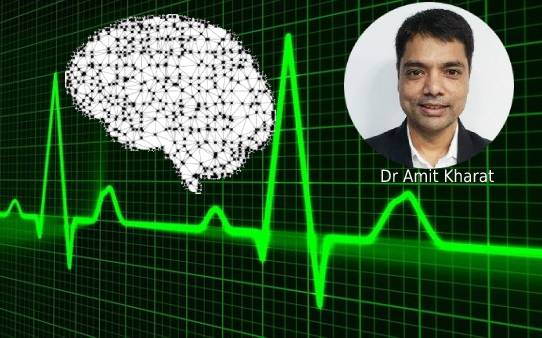
By Dr Amit Kharat, Co-Founder / CEO DeepTek
June 4 2022: Medicine is a dynamic, ever-changing field dedicated to better patient care. A well-functioning healthcare ecosystem includes hospitals, hospital management, doctors, nurses, frontline healthcare workers, insurance companies, pathology laboratories, imaging, pharmacy, pharmaceutical firms, research, and many other elements. In numerous aspects of this ecosystem, artificial intelligence (AI) has the potential to improve accuracy, precision, outcomes and substantially reduce time. It can also help the healthcare system by assisting with laboratory diagnosis, clinical diagnosis, imaging analysis, research studies, financial administration, documentation, workflow simplification, and various other tasks. Different AI approaches used in the healthcare sector include Machine Learning (ML), Deep Learning (DL), and Natural Language Processing (NLP).
Artificial intelligence (AI) is progressively being applied to healthcare as it becomes more prevalent in modern industry and everyday life. Artificial intelligence in healthcare can aid healthcare practitioners with various patient care and administrative operations, allowing them to improve on existing solutions and overcome difficulties more quickly. Although most AI and healthcare technologies are helpful in the healthcare area, their support strategies can differ significantly between hospitals and other healthcare organisations.
While some periodicals on artificial intelligence in healthcare claim that AI can perform as well as or better than humans at particular processes, such as diagnosing sickness, it will be several years before AI replaces people for a wide range of medical jobs.
Disease Detection and treatment have been at the centre of artificial intelligence AI in healthcare for the past 50 years. However, they were no better at diagnosing than humans, and their integration with clinical workflows and health record systems was less than optimal.
Whether rule-based or algorithmic, using artificial intelligence in healthcare for diagnosis and treatment plans can be challenging to integrate with clinical workflows and EHR systems. Integration problems have been a more significant hindrance to the widespread application of AI in healthcare than accuracy concerns. AI and healthcare skills for diagnosis and treatment developed by medical software companies are frequently stand-alone and focused on a single area of care (narrow or point solutions). Some EHR software suppliers are beginning to add modest AI-based healthcare analytics functionality into their product offerings, but this is still very nascent.
Artificial intelligence in healthcare offers a wide range of administrative applications. Artificial intelligence in the medical context is less game-changing than inpatient care. On the other hand, Artificial Intelligence in hospital administration can save time and money. AI's applications in healthcare include claims processing, clinical documentation, revenue cycle management, and medical records administration, to name a few.
The type of data to be interpreted determines the implementation of various AI techniques in the healthcare sector. Healthcare providers, insurance companies, pharmaceutical corporations, and research organisations are essential healthcare data sources. There are two forms of data: structured and unstructured. Data that is structured is consistent and well-organised (e.g., blood glucose values of patients taking part in a research study). On the other hand, unstructured data is unreliable and might differ significantly from one another (e.g., human language, imaging, signals such as ECG). However, the information is ready to be used for training the associated AI model after charting it on a correct timeline, reducing biases, and transforming it into a format understandable by the corresponding AI application.
Machine learning, which may be used to match data across different databases, is another application of artificial intelligence in healthcare for claims and payment administration. For example, insurers and providers must double-check the accuracy of the millions of claims submitted every day. Detecting and fixing coding errors and false claims saves time, money, and resources for all parties involved.
The most challenging hurdle for AI in healthcare is assuring its acceptance in daily clinical practice, not whether the technologies are capable enough to be helpful. Clinicians may eventually gravitate toward activities that need distinctively human skills and the highest level of cognition. Only those healthcare professionals who refuse to collaborate will likely miss out on AI's full potential.
The Challenges of AI in Healthcare
The quality, amount, and type of data utilised to train and evaluate any AI model is one of the most crucial elements for its success. Due to the increasing growth of medical data, using the most recent and reliable data access is critical. It's also essential to update the model regularly with new data. AI systems can detect only correlation. They don't establish causation. As a result, it's critical to check whether the model's input and output correlation approaches are correct. Complex correlations anticipated by the model are frequently difficult to interpret.
The crux is that Artificial Intelligence in Healthcare is here to stay, it is only a matter of time and usage that it will become an integral part of this industry. Collectively it is the responsibility of all key stakeholders to ensure its optimal usage and constant up gradation to meet the versatile demands of the healthcare sector.
DeepTek’s mission is to make quality radiology services more affordable and accessible by leveraging the power of AI. Dr Amit Kharat is Co-Founder / CEO / Radiology Domain Expert @DeepTek. Amit started his radiology practice in 2002 and started his entrepreneurial journey in 2004 when he commenced a successful teleradiology practice. He is a clinical radiologist (MBBS Yr-1999, DMRD Yr-2002 (Pune University), DNB Yr-2004), researcher (PhD Yr-2013 (D Y Patil University) in Musculoskeletal Imaging, Professor of Radiology (Dr D Y Patil Medical Hospital, Pune) and Guide.